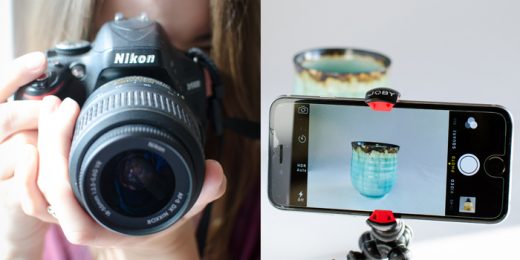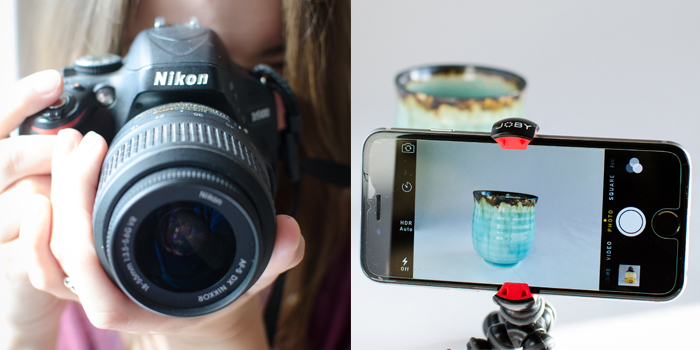Product Photography Tips and Tricks
May 6, 2016
Product photography is always evolving, and there’s always something exciting just around the corner. If you run an eCommerce store, don’t just wait around for the next trend to come along — keep an eye out and you’ll find individuals and eCommerce stores doing incredible new things to make their product photos POP.
Missed our previous post about product photography? Read it here: How to Take Amazing Product Photos With Your Smartphone
Below are some of the biggest product photography trends that have taken off. If you haven’t already, make sure you jump on board!
1. Take the photos yourself
In the digital age, everything is becoming more accessible with every passing moment. DSLRs are always getting cheaper, there’s tons of information on the internet about how to create great photography and smartphone cameras are getting so good you can take clear, stunning photos with them.

That said, it’s no wonder more and more eCommerce storeowners are taking product photography into their own hands. With a bit of practice and an understanding of the basics, you’ll be able to shoot amazing photos that you’d be proud to upload to your eCommerce store. Here are some things to keep in mind:
Understand your camera
Over the years smartphone cameras have gotten better — so good, in fact, that they can be used to take great product images. Smartphones are extremely easy to use, making them the obvious choice if you’re not tech-savvy. You’re also likely to have one on hand, and they have the added benefit of syncing the photos to the cloud automatically.
The key is to avoid using the in-built flash, the zoom function, and any predefined filters and frames. All of these features will decrease the quality of the photo, which is why adjustments to the color and size should always be made during the editing stage. You should also take advantage of the auto-focus and tap on the product prior to taking the photo.
When it comes to cameras, you do get what you pay for and in the end, a DSLR will take better photos if you know how to use it. If you plan on shooting frequently and are willing to spend the money as well as the time on learning how to use it, it’s worth the investment.
There’s no such thing as the perfect combination of settings for product photography, as it’ll depend on your setup and your products. However, an understanding of aperture, shutterspeed, and ISO will help you find what works best for you.
The aperture is the hole within the lens that determines the amount of light that travels into the camera. It’s measured in f-stops, and increasing the f-stop number makes the aperture smaller (which means the camera will let in less light and product a darker photo).
The aperture also determines how much of the frame is in focus — a small aperture will clearly capture everything in the frame whereas a larger aperture will isolate the background from the foreground. In the end, you need to find an aperture that gets the entire product in focus but also produces a well-lit photo. If you look at the photos below, the left photo was taken with an aperture of f/1.8. The photo on the right was taken with an aperture of f/10.

The shutter speed is the speed at which the hole in the lens opens and closes. The slower the shutter speed, the brighter the photo and vice versa. Small apertures should be paired with slow shutter speeds; the two photos below were taken with an aperture of f/10, but with shutter speeds of 1/320 and 1/50 respectively. I’ve removed the background to clearly show the difference.

And finally, the ISO is your camera’s sensitivity to light. You want to keep the ISO below 400, as exceeding this number will give you a grainy photo. The quality loss is particularly noticeable when you zoom in.

If you’re unable to take a well-lit photo under 400, you need to increase the intensity of your light sources.
As mentioned earlier, there’s no perfect combination of the three. You’ll just need to take the time adjusting the settings until you find what works for you.
Shoot against a white backdrop
A white backdrop will reflect light onto your product and help get your camera’s white balance calibration on point. The best kind of backdrop is one that seamlessly transitions from the vertical to the horizontal surface.
For large products, you can purchase a professional photography sweep (which has the benefit of coming with a stand) or you’ll need to improvise and drape a white sheet over something. For smaller products, you can buy a shooting table or make your own with some scrap wood, clamps, and an old table.

Use sufficient lighting
Great natural lighting is the key to great product photos. Unless you know what you’re doing, stay away from artificial lighting. It takes years of practice and a lot of experience, not to mention the equipment is expensive if you buy the real gear.
Natural lighting is the way to go with DIY product photography. You want to use the sun directly, so the best place to shoot is usually near a window. If you find that the light is too intense, it’s a good idea to diffuse it by covering the window with a white sheet or some paper.
You want the window to the left or right of the product — never facing or behind the camera — which means the light source will only hit the product from one side.

For an evenly lit product, you’re going to want to place something, such as a reflector, on the opposite side of the product to reflect the light. You can purchase a photography reflector, but it’ll also work if you cover a piece of cardboard with aluminium foil.

Stabilize your camera
Use a tripod or a smartphone mount to get the sharpest photos possible. Stabilizing your camera is the best way to ensure you have track-sharp images. You can find tripods on Amazon for under $ 50 which are stable enough for product photography.

2. Use a white background
With Amazon including making it mandatory to have a product on a white background and eBay only including products on a white background in the seller collection, these two leading eCommerce platforms have set a benchmark for product photography.
A white background has become a standard feature for professional product shots. It’s clean, simple, free from distraction, and naturally draws attention to the product itself.

Major brands have been catching on to using white backgrounds, keeping consumers hooked on their online stores. For example, Birchbox, Aldo (see example below) and even the photography masters at Nikon use white backgrounds for their product photos. Consumers love how clearly products are presented on white backgrounds, and you should seriously consider following the trend!

To get this effect, you can remove backgrounds in the editing stage. The most accurate method is to use Adobe Photoshop’s pen tool, which allows you to draw a path around the product and cut the background away. Click here for a step-by-step guide with pictures on how to do this. And once you’ve removed the background, you can do cool things such as create a ghost mannequin effect or add drop shadows and reflections.

3. Outsource the editing
If you don’t have the time to edit your product images, you can always outsource this task.
Outsourcing in general lets you focus on what you do well and can skyrocket efficiency in your business. You don’t have to spend hours learning how to edit and polish photos; instead, you can turn your attention toward increasing revenue, expanding your product line and growing your brand presence.
Conclusion
As I said earlier, product photography is constantly changing. It’s important to jump on board the latest trends as a way of keeping up with the eCommerce community and driving traffic to your store.
Not sure where to look? Start by looking at featured stores or sellers on eCommerce platforms and take note of what they’re doing. You could also look at stores that are mentioned across eCommerce blogs as examples for stores that are doing it right.
Digital & Social Articles on Business 2 Community
(55)














